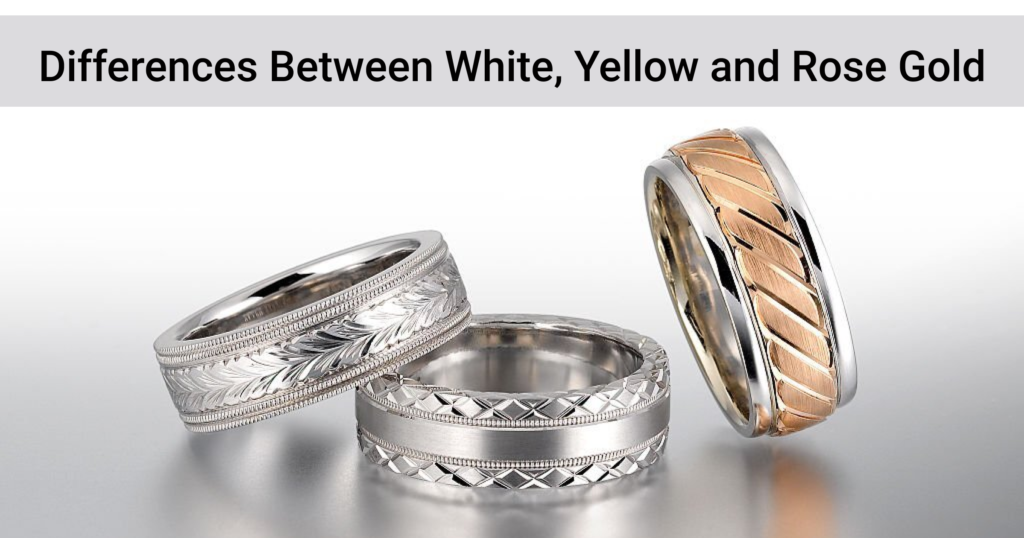Differences between white, yellow and rose gold
Gold has been considered one of the most expensive types of alloys for centuries. It is recognized as a symbol of tradition, royalty and grace. Raw gold is converted into other forms to make it usable and worthy. The types of gold are based on their composition and colors. Here is a brief introduction to the three types of gold:

White Gold:
White gold is recognized by several properties which are listed below:
Composition:
White gold is an amalgam of pure gold and other metals such as palladium, nickel, copper, silver and zinc. It is plated with a thin layer of rhodium to make it more shiny and silvery in appearance.
Durability:
It is a durable form of gold. It also contains other metals such as palladium, nickel and rhodium coating. The presence of these metals increases its durability and strength.
Rhodium plating:
It is one of the properties of white gold that makes it unique from the other forms of gold. Rhodium is an expensive metal from the platinum group which increases the worth of white gold. Moreover, it gives strength and minimizes tarnishing.
Maintenance:
It may require a little maintenance from time to time as rhodium plating can be worn out.
Worth:
White gold can be more expensive than the other forms of gold because of rhodium plating. It depends upon the amount of pure gold present in it.
Alloys used:
The alloys used in white gold are copper, silver, nickel, zinc, palladium and rhodium coating.
Advantages:
White gold is preferred, because of its various advantages such as its sleek and luxurious look, affordability, durability, rhodium coating and elegance.
Disadvantages:
White gold has disadvantages such as tarnishing with time, people’s sensitivity to copper or nickel, need for more maintenance to protect rhodium coating and less worth than pure gold because of addition of other alloys.
Yellow Gold:
The properties of yellow gold are listed below:
Composition:
It is the pure form and color of gold. Yellow gold is made up of pure gold, copper and a small proportion of zinc or silver.
Durability:
It is more durable as compared to other forms of gold because of its purity and high proportion of pure gold.
Low reactivity:
It has low reactivity so it doesn’t get tarnished easily.
Maintenance:
It needs low maintenance as compared to white gold because it is resistant to tarnishing.
Worth:
The worth of yellow gold is higher than other types of gold because it has a pure form of gold. The worth depends upon the proportion of pure gold which is measured in “karats”.
Malleability:
It is the raw form of gold and can be easily molded into other shapes and designs.
Timelessness:
It has always been considered as a symbol of tradition and royalty and has never lost its worth over decades.
Alloys Used:
The alloys mainly used are copper (to give it more yellowish color), small amounts of zinc (to make it more durable) and silver (to make it shinier and sleek).
Advantages:
It has many advantages over other forms of gold, such as its timeless look and hue makes it top choice, its durability and low maintenance, and high worth because of more proportion of pure gold.
Disadvantages:
Some of the disadvantages of yellow gold are its malleability, prone to scratches, high rates and typical appearance.
Rose Gold:
The properties of rose gold are listed below:
Composition:
Rose gold is mainly composed of pure gold, copper and zinc. The amount of copper determines the shades of red and pink.
Durability:
Because of the presence of zinc and copper, rose gold is durable and needs low maintenance.
Versatility:
The feminine and trendy look of rose gold has marked its popularity in women’s Jewelry.
Uniqueness:
Rose gold is unique for people who seek pieces that are elegant and unconventional.
Alloys used:
The alloys mainly used are pure gold, zinc, copper and small amounts of additional metals to increase its durability and strength.
Advantages:
Rose gold has become a top choice for people for the past few years because of its uniqueness, feminine and graceful appearance and affordability.
Disadvantages:
Besides many advantages, rose gold has certain disadvantages as well.This includes its less availability, less worth because of mixing of other metals and color preferences.
Conclusion:
White, yellow and rose gold have their distinct properties and value. Each type has its own features and value. The main differences are their durability, worth and appearance.
FAQs:
1. Is white gold more expensive than yellow gold?
White gold shouldn’t be more expensive than yellow gold because it has less proportion of pure gold as compared to yellow gold. But the overall price of white gold is determined by the procedure of rhodium coating, designs and processes involved to make it sleek and shinier, hence, can make it a bit expensive.
2. Does rose gold fade or tarnish over time?
Generally, rose gold doesn’t tarnish with time but it requires timely cleaning and polishing in order to preserve its shine and luster.
Yellow Gold:
24-karat gold is considered the purest form in this regard. But other metals such as zinc and copper are mixed with gold to make it more durable.
Rose Gold:
It is also known as pink or red gold. Rose gold is an alloy made up of pure gold mixed with a high amount of copper to give it red or pink color. The amount of copper decides the richness of red or pink color in this type of gold.

